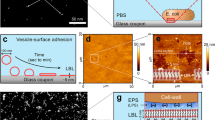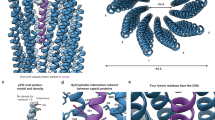Abstract
In nature, bacteria primarily live in surface-attached, multicellular communities, termed biofilms1,2,3,4,5,6. In medical settings, biofilms cause devastating damage during chronic and acute infections; indeed, bacteria are often viewed as agents of human disease7. However, bacteria themselves suffer from diseases, most notably in the form of viral pathogens termed bacteriophages8,9,10,11,12, which are the most abundant replicating entities on Earth. Phage–biofilm encounters are undoubtedly common in the environment, but the mechanisms that determine the outcome of these encounters are unknown. Using Escherichia coli biofilms and the lytic phage T7 as models, we discovered that an amyloid fibre network of CsgA (curli polymer) protects biofilms against phage attack via two separate mechanisms. First, collective cell protection results from inhibition of phage transport into the biofilm, which we demonstrate in vivo and in vitro. Second, CsgA fibres protect cells individually by coating their surface and binding phage particles, thereby preventing their attachment to the cell exterior. These insights into biofilm–phage interactions have broad-ranging implications for the design of phage applications in biotechnology, phage therapy and the evolutionary dynamics of phages with their bacterial hosts.
This is a preview of subscription content, access via your institution
Access options
Access Nature and 54 other Nature Portfolio journals
Get Nature+, our best-value online-access subscription
$29.99 / 30 days
cancel any time
Subscribe to this journal
Receive 12 digital issues and online access to articles
$119.00 per year
only $9.92 per issue
Buy this article
- Purchase on Springer Link
- Instant access to full article PDF
Prices may be subject to local taxes which are calculated during checkout




Similar content being viewed by others
References
Flemming, H.-C. et al. Biofilms: an emergent form of bacterial life. Nat. Rev. Microbiol. 14, 563–575 (2016).
Persat, A. et al. The mechanical world of bacteria. Cell 161, 988–997 (2015).
Hobley, L., Harkins, C., MacPhee, C. E. & Stanley-Wall, N. R. Giving structure to the biofilm matrix: an overview of individual strategies and emerging common themes. FEMS Microbiol. Rev. 39, 649–669 (2015).
Berk, V. et al. Molecular architecture and assembly principles of Vibrio cholerae biofilms. Science 337, 236–239 (2012).
Drescher, K. et al. Architectural transitions in Vibrio cholerae biofilms at single-cell resolution. Proc. Natl Acad. Sci. USA 113, E2066–E2072 (2016).
Nadell, C. D., Drescher, K., Wingreen, N. S. & Bassler, B. L. Extracellular matrix structure governs invasion resistance in bacterial biofilms. ISME J. 9, 1700–1709 (2015).
Ochman, H. & Moran, N. A. Genes lost and genes found: evolution of bacterial pathogenesis and symbiosis. Science 292, 1096–1099 (2001).
Samson, J. E., Magadán, A. H., Sabri, M. & Moineau, S. Revenge of the phages: defeating bacterial defences. Nat. Rev. Microbiol. 11, 675–687 (2013).
Zeng, L. et al. Decision making at a subcellular level determines the outcome of bacteriophage infection. Cell 141, 682–691 (2010).
Salmond, G. P. C. & Fineran, P. C. A century of the phage: past, present and future. Nat. Rev. Microbiol. 13, 777–786 (2015).
Rohwer, F. & Segall, A. M. In retrospect: a century of phage lessons. Nature 528, 46–48 (2015).
Hu, B., Margolin, W., Molineux, I. J. & Liu, J. The bacteriophage T7 virion undergoes extensive structural remodeling during infection. Science 339, 576–579 (2013).
Koskella, B. & Brockhurst, M. A. Bacteria–phage coevolution as a driver of ecological and evolutionary processes in microbial communities. FEMS Microbiol. Rev. 38, 916–931 (2014).
Gómez, P. & Buckling, A. Bacteria–phage antagonistic coevolution in soil. Science 332, 106–109 (2011).
Weitz, J. S., Hartman, H. & Levin, S. A. Coevolutionary arms races between bacteria and bacteriophage. Proc. Natl Acad. Sci. USA 102, 9535–9540 (2005).
Forde, S. E. et al. Understanding the limits to generalizability of experimental evolutionary models. Nature 455, 220–223 (2008).
Bull, J. J., Otto, G. & Molineux, I. J. In vivo growth rates are poorly correlated with phage therapy success in a mouse infection model. Antimicrob. Agents Chemother. 56, 949–954 (2012).
Chan, B. K. & Abedon, S. T. Bacteriophages and their enzymes in biofilm control. Curr. Pharm. Des. 21, 85–99 (2015).
Doolittle, M. M., Cooney, J. J. & Caldwell, D. E. Tracing the interaction of bacteriophage with bacterial biofilms using fluorescent and chromogenic probes. J. Ind. Microbiol. 16, 331–341 (1996).
Lu, T. K. & Collins, J. J. Dispersing biofilms with engineered enzymatic bacteriophage. Proc. Natl Acad. Sci. USA 104, 11197–11202 (2007).
Briandet, R. et al. Fluorescence correlation spectroscopy to study diffusion and reaction of bacteriophages inside biofilms. Appl. Environ. Microbiol. 74, 2135–2143 (2008).
May, T., Tsuruta, K. & Okabe, S. Exposure of conjugative plasmid carrying Escherichia coli biofilms to male-specific bacteriophages. ISME J. 5, 771–775 (2011).
Vilas Boas, D. et al. Discrimination of bacteriophage infected cells using locked nucleic acid fluorescent in situ hybridization (LNA-FISH). Biofouling 32, 179–190 (2016).
Serra, D. O., Richter, A. M., Klauck, G., Mika, F. & Hengge, R. Microanatomy at cellular resolution and spatial order of physiological differentiation in a bacterial biofilm. mBio 4, e00103–13 (2013).
DePas, W. H. et al. Iron induces bimodal population development by Escherichia coli. Proc. Natl Acad. Sci. USA 110, 2629–2634 (2013).
Grantcharova, N., Peters, V., Monteiro, C., Zakikhany, K. & Römling, U. Bistable expression of CsgD in biofilm development of Salmonella enterica serovar Typhimurium. J. Bacteriol. 192, 456–466 (2010).
Pesavento, C. et al. Inverse regulatory coordination of motility and curli-mediated adhesion in Escherichia coli. Genes Dev. 22, 2434–2446 (2008).
Besharova, O., Suchanek, V. M., Hartmann, R., Drescher, K. & Sourjik, V. Diversification of gene expression during formation of static submerged biofilms by Escherichia coli. Front. Microbiol. 7, 1568 (2016).
Reyes, A., Semenkovich, N. P., Whiteson, K., Rohwer, F. & Gordon, J. I. Going viral: next-generation sequencing applied to phage populations in the human gut. Nat. Rev. Microbiol. 10, 607–617 (2012).
Pires, D. P., Oliveira, H., Melo, L. D. R., Sillankorva, S. & Azeredo, J. Bacteriophage-encoded depolymerases: their diversity and biotechnological applications. Appl. Microbiol. Biotechnol. 100, 2141–2151 (2016).
Arnqvist, A., Olsén, A., Pfeifer, J., Russell, D. G. & Normark, S. The Crl protein activates cryptic genes for curli formation and fibronectin binding in Escherichia coli HB101. Mol. Microbiol. 6, 2443–2452 (1992).
Olsén, A., Jonsson, A. & Normark, S. Fibronectin binding mediated by a novel class of surface organelles on Escherichia coli. Nature 338, 652–655 (1989).
Zhou, Y., Smith, D. R., Hufnagel, D. A. & Chapman, M. R. Experimental manipulation of the microbial functional amyloid called curli. Methods Mol. Biol. 966, 53–75 (2013).
Acknowledgements
The authors thank M. Rakwalska-Bange, T. Heimerl and G. Malengo for experimental assistance, R. Hengge and V. Sourjik for strains and N. Rigel and members of the Drescher laboratory for discussions and suggestions. This work was supported by grants from the Max Planck Society, Behrens Weise Foundation, European Research Council (StG-716734), Human Frontier Science Program (CDA00084/2015-C) and Deutsche Forschungsgemeinschaft (SFB987) to K.D., and the Alexander von Humboldt Foundation and Cystic Fibrosis Foundation (STANTO15RO) to C.D.N.
Author information
Authors and Affiliations
Contributions
C.D.N. conceived the topic. C.D.N. and K.D. designed the project. L.V. and P.K.S. generated strains and acquired data. R.H. developed new analytical software. L.V., R.H., C.D.N. and K.D. analysed and interpreted the data. L.V., C.D.N. and K.D. wrote the paper with the help of all authors.
Corresponding authors
Ethics declarations
Competing interests
The authors declare no competing financial interests.
Additional information
Publisher’s note: Springer Nature remains neutral with regard to jurisdictional claims in published maps and institutional affiliations.
Electronic supplementary material
Supplementary Information
Supplementary Figures 1–10, Supplementary Table 1, Supplementary References.
Rights and permissions
About this article
Cite this article
Vidakovic, L., Singh, P.K., Hartmann, R. et al. Dynamic biofilm architecture confers individual and collective mechanisms of viral protection. Nat Microbiol 3, 26–31 (2018). https://doi.org/10.1038/s41564-017-0050-1
Received:
Accepted:
Published:
Issue Date:
DOI: https://doi.org/10.1038/s41564-017-0050-1
This article is cited by
-
Cell-lysis sensing drives biofilm formation in Vibrio cholerae
Nature Communications (2024)
-
Role of Virus on Oral Biofilm: Inducer or Eradicator?
Applied Biochemistry and Biotechnology (2024)
-
Slow growing bacteria survive bacteriophage in isolation
ISME Communications (2023)
-
Bacterial defences: mechanisms, evolution and antimicrobial resistance
Nature Reviews Microbiology (2023)
-
Nutrients strengthen density dependence of per-capita growth and mortality rates in the soil bacterial community
Oecologia (2023)



